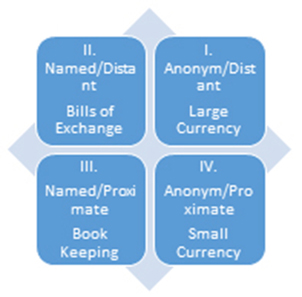October 13, 2016 – On 17 and 18 November 2016 the DAMIN research project will held a workshop on ‘The Variety of Exchange and the Character of Money’. The event is organised by Akinobu Kuroda (U of Tokyo/Ecole Normale Supérieure, Paris) in cooperation
with Georges Depeyrot (CNRS/Ecole Normale Supérieure, Paris) and will take place at Salle Dussane, Ecole Normale Supérieure, 45 rue d’Ulm, 75005 Paris. This meeting is supported by Ecole Normale Supérieure, Paris, and Japan Society for the Promotion of Science (project No 26285073) and is an unclosed meeting.
Aims
by Akinobu KURODA
No one would deny that money is a means of exchange. However, historically, exchanges between people have had different characteristics, and the devices used to mediate those exchanges (i.e. money, as a means of exchange) have reflected those characteristics.
All exchanges have two, binary characteristics. The first characteristic is the degree of familiarity of the participants: an exchange can either occur anonymously or within a named relationship. As we use this term, the degree of familiarity does not refer to whether a seller and a buyer are acquaintances or strangers, but rather to whether or not the act of making a transaction creates a bond that constrains subsequent transactions.
The second characteristic of an exchange is its distance: a trade can be made either proximately or distantly. By distance we do not refer simply to physical distance, but rather to the size of the value of the exchange and its frequency. Proximate exchanges tend to be of small value and to be made more frequently than distant ones. In addition, in agricultural societies, the former is more affected by seasonality than the latter.
Four Quadrants of Exchange.
All exchanges have these binary characteristics of familiarity and distance. There are, therefore, four different kinds of exchanges, which we can represent with four quadrants. People in societies have tried to make different devices to mediate all four kinds of exchanges. A typical case appears in the figure below, in which large currency is used for anonymous/distant exchanges (Quadrant I), bills of exchange for named/distant exchanges (Quadrant II), book keeping for named/proximate exchanges (Quadrant III), and small currency is used for anonymous/proximate exchanges (Quadrant IV).
In reality, the four Quadrants seamlessly cover all exchanges, and a given device thus may mediate exchanges characterized by one Quadrant in one context only to function later in a different Quadrant. For example, bills of exchange that were initially characterized by Quadrant II sometimes could function as currencies in Quadrant I or even in IV. The boundaries demarcating the different Quadrants are also not of uniform clarity. The distinction between Quadrants II and III is fuzzy, while there is a considerable difference between the sporadic exchanges that characterise Quadrant I and the constant exchanges of Quadrant IV.
Making comparisons that cover practically the entire globe, this workshop aims to reveal the variety of ways in which the four Quadrants can be combined, to trace the trajectories of their transformations, and to subsequently indicate why money cannot be easily unified.
TIME SCHEDULE (still in progress)
17 November
Part I 1:00pm-3:00pm
Kuroda, Akinobu (U of Tokyo): The Variety of Exchange and the Character of Money
Georgina Gomez (IISS, The Hague): Revisiting Currency Circuits and their intersections
Part II 3:30pm-5:30pm
Jürgen Nautz (U of Applied Sciences, Warburg): Four Quadrants of Exchange – How useful is Schumpeter’s concept of the social nature of money?
Markus Denzel (Leipzig University): The Relevance of Book-Keeping for Cashless Payment, 14th to 19th Century
18 November
Part III 9:00am-12:00am
Patrice Baubeau (Paris X): Dogfights over chicken feed? French petty coins circulation and late 19th century small change riots
Oscar Gelderblom (U of Utrecht) and Joost Jonker (U of Utrecht): A haunted history: ghost money implications for the history of money
Willem Wolters (Nijmegen U): What does a comparison between the small currency systems of nineteenth century Java (part of the colony Netherlands Indies) and the Philippines (Spanish colony) tell us about the socio-economic structure of both colonies?
Part IV 1:00pm-3:00pm
Marisa Candotti (SOAS): The character of money and changing pattern of transitions across the Sahara and two states of the West African savanna (c. 1800)
Tanabe, Akio (U of Tokyo): Various Forms of Exchange in Early Modern India: Money that Connects Market, Society and Polity
Part V 3:30pm-5:00pm
General Discussion
Commentators
Jean Cartelier (Paris X), Georges Depeyrot (CNRS/ENS, Paris), Michael North (U of Greifswald)
To learn more about DAMIN or if you want to check out the most recent information on the forthcoming congress go to the DAMIN website.





